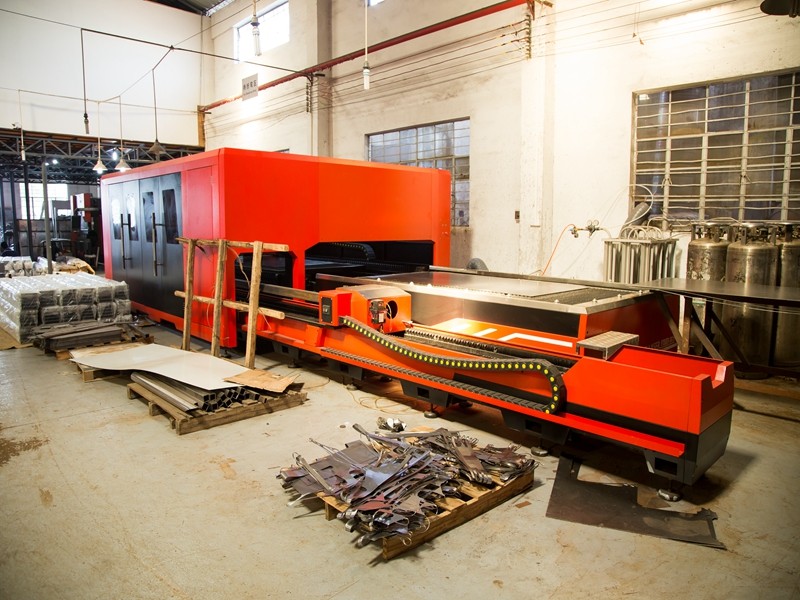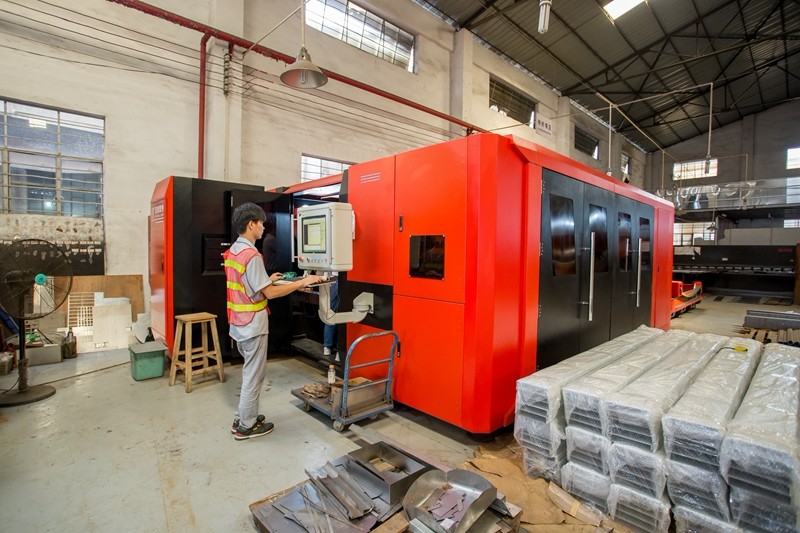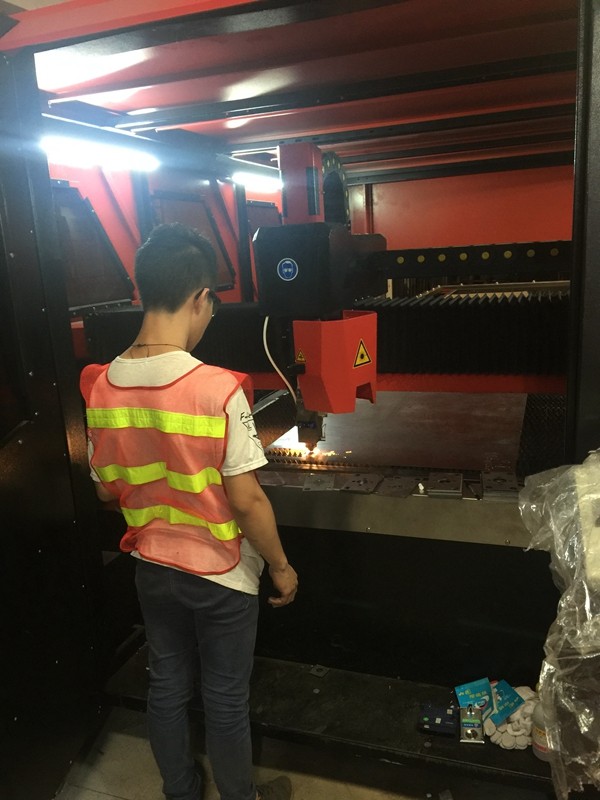The laser cutting device can cut stainless steel below 4mm, and oxygen can be cut into 20mm thick carbon steel in the laser beam, but after oxygen cutting, a thin oxide film is formed on the cutting surface. The maximum thickness of the cut can be increased to 20 mm, but the dimensional error of the cutting member is large.

The price of laser cutting equipment is quite expensive, about 1.5 million yuan. However, the use of such equipment in large production is still feasible due to the reduced cost of subsequent processing. Since there is no tooling cost, laser cutting equipment is also suitable for the production of small quantities of parts of various sizes that were previously unprocessable. Laser cutting equipment typically employs a computerized digital control (CNC) device that allows the cutting of data from a computer-aided design (CAD) workstation using a telephone line.
Classification
1. Laser vaporization cutting: When laser melting and cutting, the metal material is melted by laser heating, and then non-oxidizing gas (Ar, He, N, etc.) is sprayed through a nozzle coaxial with the beam, and the liquid metal is made by the strong pressure of the gas. Drain and form a slit. Laser melt cutting does not require complete vaporization of the metal, and the required energy is only 1/10 of the vaporization cut. Laser melt cutting is mainly used for the cutting of some non-oxidizable materials or active metals, such as stainless steel, titanium, aluminum and their alloys.
2. Laser oxygen cutting: laser oxygen cutting principle is similar to oxyacetylene cutting. It uses a laser as a preheating heat source and uses an active gas such as oxygen as a cutting gas. On the one hand, the injected gas acts on the cutting metal to cause an oxidation reaction to release a large amount of heat of oxidation; on the other hand, the molten oxide and the melt are blown out from the reaction zone to form a slit in the metal. Since the oxidation reaction during the cutting process generates a large amount of heat, the energy required for laser oxygen cutting is only 1/2 of that of the melt cutting, and the cutting speed is much larger than the laser vaporization cutting and the melting cutting. Laser oxygen cutting is mainly used for easily oxidized metal materials such as carbon steel, titanium steel and heat-treated steel.
3. Laser dicing and control fracture; laser dicing is to use a high energy density laser to scan the surface of the brittle material, so that the material is evaporated by heat to a small groove, and then apply a certain pressure, the brittle material will be along the small groove split. Lasers for laser scribing are generally Q-switched lasers and CO2 lasers. Controlling the fracture is a steep temperature distribution created by laser engraving, creating local thermal stresses in the brittle material that cause the material to break along the small grooves.
Characteristics
1. Good cutting quality
Laser cutting can achieve better cutting quality due to the small laser spot, high energy density and fast cutting speed.
1) The laser cutting slit is narrow, the slits are parallel and perpendicular to the surface, and the dimensional accuracy of the cut parts can reach ±0.05mm.
2) The cutting surface is smooth and beautiful, the surface roughness is only a few tens of micrometers, and even laser cutting can be used as the last process, no mechanical processing is required, and the parts can be directly used.
3) After the laser is cut by the laser, the width of the heat-affected zone is small, the performance of the material near the slit is almost unaffected, and the deformation of the workpiece is small, the cutting precision is high, the geometry of the slit is good, and the shape of the slit cross-section is relatively high. Regular rectangle. The comparison of laser cutting, oxyacetylene cutting and plasma cutting methods is shown in Table 1. The cutting material is a 6.2 mm thick low carbon steel plate.
2. High cutting efficiency
Due to the transmission characteristics of the laser, the laser cutting machine is generally equipped with multiple numerical control worktables, and the entire cutting process can realize numerical control. During operation, it is only necessary to change the numerical control program to apply the cutting of different shapes of parts, which can perform two-dimensional cutting and three-dimensional cutting.
3. Cutting speed
Cutting a 2mm thick low carbon steel plate with a power of 1200W, the cutting speed can reach 600cm/min; cutting a 5mm thick polypropylene resin plate, the cutting speed can reach 1200cm/min. The material does not need to be clamped and fixed during laser cutting, which saves the fixture and saves the auxiliary time of loading and unloading.
4. Non-contact cutting
There is no contact between the torch and the workpiece during laser cutting, and there is no tool wear. To machine parts of different shapes, there is no need to change the "tool", just change the output parameters of the laser. The laser cutting process has low noise, low vibration and no pollution.
5. The variety of cutting materials
Compared with oxyacetylene cutting and plasma cutting, there are many types of laser cutting materials, including metal, non-metal, metal-based and non-metal matrix composites, leather, wood and fiber. However, for different materials, due to their different thermophysical properties and different absorption rates of laser light, different laser cutting adaptability is exhibited. The laser cutting performance of various materials is shown in Table 2 using a CO2 laser.
6. Shortcomings
1) Laser cutting Due to the limitation of laser power and equipment volume, laser cutting can only cut medium and small thickness plates and tubes, and as the thickness of the workpiece increases, the cutting speed decreases significantly.
2) The cost of laser cutting equipment is high and the one-time investment is large.

Main characteristics
1. Small deformation of the slit and small workpiece
The laser beam is focused into a small spot that achieves a high power density at the focus. At this time, the heat input by the beam far exceeds the portion that is reflected, conducted or diffused by the material, and the material is quickly heated to a degree of vaporization to evaporate to form a hole. As the beam moves relatively linearly with the material, the holes are continuously formed into slits of narrow width. The trimming is minimally affected by heat and there is essentially no deformation of the workpiece.
An auxiliary vapor body suitable for the material to be cut is also added during the cutting process. The steel is cut with oxygen as the auxiliary vapor and the molten metal to generate an exothermic chemical reaction to oxidize the material, while helping to blow away the slag in the slit. A type of plastic that cuts polypropylene uses compressed air, and flammable materials such as cotton and paper are cut to use inert gas. The auxiliary vapor entering the nozzle also cools the focusing lens, preventing smoke from entering the lens holder and contaminating the lens and causing the lens to overheat.
Most organic and inorganic materials can be laser cut. In the metal processing industry where industrial manufacturing systems are heavily weighted, many metal materials, regardless of their hardness, can be cut without distortion. Of course, for high reflectivity materials such as gold, silver, copper and aluminum alloys, they are also good heat transfer conductors, so laser cutting is difficult or even impossible. Laser cutting without burrs, wrinkles, high precision, better than plasma cutting. For many electromechanical manufacturing industries, modern laser cutting systems controlled by microcomputers can easily cut workpieces of different shapes and sizes, which are often preferred over die cutting and molding processes; although they are slower than die punching, However, it has no mold consumption, no need to repair the mold, and saves the time for changing the mold, thereby saving processing costs and reducing production costs, so it is more cost-effective to consider.
2. Contactless processing
The laser beam is focused to form a very small point of action with very strong energy, and its application to cutting has many features. First, the conversion of laser light energy into amazing thermal energy is maintained in a very small area, providing (1) narrow straight edge slits; (2) minimal heat affected zone adjacent to the trim; and (3) minimal local deformation. Secondly, the laser beam does not exert any force on the workpiece. It is a non-contact cutting tool, which means (1) the workpiece has no mechanical deformation; (2) no tool wear, and no problem with the conversion of the tool; (3) the hardness of the cutting material does not need to be considered. That is, the laser cutting ability is not affected by the hardness of the material to be cut, and any hardness material can be cut. Once again, the laser beam is highly controllable and has high adaptability and flexibility. Therefore, (1) it is convenient to combine with the automation equipment, and it is easy to automate the cutting process. (2) Since there is no restriction on the cutting workpiece, the laser beam has an infinite imitation. Shape cutting ability; (3) combined with the computer, the whole board can be discharged, saving materials.
3. Adaptability and flexibility
Laser cutting has greater flexibility than other conventional processing methods. First, as with other thermal cutting methods, as a thermal cutting process, other methods cannot act as a laser beam on a very small area, resulting in a wide slit, a large heat affected zone, and significant workpiece deformation. Lasers can cut non-metals, while other thermal cutting methods do not.
In general, laser cutting quality can be measured by the following six criteria.
1) Cutting surface roughness Rz
2) Cutting slag size
3) trimming verticality and slope u
4) Cutting edge rounded size r
5) After the stripe drag n
6) Flatness F
Application range
Most laser cutting machines are controlled by CNC programs or made into cutting robots. As a sophisticated machining method, laser cutting can cut almost all materials, including 2D or 3D cutting of thin metal sheets.
In the field of automobile manufacturing, the cutting technology of space curves such as car roof windows has been widely used. Volkswagen AG uses a 500W laser to cut complex body sheets and various curved parts. In the aerospace industry, laser cutting technology is mainly used for the cutting of special aviation materials, such as titanium alloy, aluminum alloy, nickel alloy, chrome alloy, stainless steel, cerium oxide, composite materials, plastics, ceramics and quartz. Aerospace components processed by laser cutting include engine flame tube, titanium alloy thin-wall machine, aircraft frame, titanium alloy skin, wing long stern, tail siding, helicopter main rotor, space shuttle ceramic heat insulation tile, etc.
Laser cutting forming technology also has a wide range of applications in the field of non-metallic materials. It can cut not only high hardness and brittle materials, such as silicon nitride, ceramics, quartz, etc., but also flexible materials such as cloth, paper, plastic sheets, rubber, etc., such as laser cutting for clothing, saving material 10 %~12%, improve the efficacy by more than 3 times.
Advantage:
Laser cutting technology has the following advantages:
1. High precision: positioning accuracy 0.05mm, repeat positioning accuracy 0.02mm.
2. Narrow slit: the laser beam is focused into a small spot, so that the focus reaches a very high power density, the material is heated to the degree of gasification, evaporation to form holes. As the beam moves relatively linearly with the material, the holes are continuously formed into slits of narrow width. The width of the slit is generally 0.10-0.20 ram.
3. The cutting surface is smooth: the cutting surface is free of burrs, the surface roughness of the cutting is generally controlled in Ral2.5; A.
4. Fast speed: cutting speed can reach lOm / min, the maximum positioning speed can reach 70m / m / n, much faster than the line cutting speed.
5. Good cutting quality: no contact cutting, the edge is affected by heat is very small, there is basically no thermal deformation of the workpiece, completely avoiding the collapse formed when the material is punched and sheared, the slit generally does not require secondary processing.
6. No damage to the workpiece: the laser cutting head will not contact the surface of the material to ensure that the workpiece is not scratched.
7. It is not affected by the hardness of the material to be cut: the laser can process steel plates, stainless steel, aluminum alloy plates, hard alloys, etc., regardless of the hardness, can be cut without deformation.
8. Not affected by the shape of the workpiece: laser processing flexibility, can process any graphics, can cut pipes and other profiles.
9. Can be used for cutting non-metal: such as plastic, wood, PVC, leather, textiles and plexiglass.
10. Saving mold investment: laser processing does not need mold, no mold consumption, no need to repair the mold, saving time to replace the mold, thereby saving processing costs, reducing production costs, especially suitable for processing large products.
11. Material saving: computer programming can be used to cut the entire board material in different shapes to maximize the utilization of materials.
12. Shortened the new product manufacturing cycle: new product trial production, a small number, the structure is uncertain, will change at any time ‘, can not die, laser cutting machine has greatly shortened the new product manufacturing cycle, reducing mold investment.


